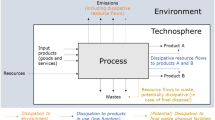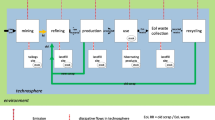Abstract
Industrial ecologists have, to an increasing extent, been using materials (and substance) flow analyses to construct cycles of metals in defined geographical areas in order to get a better understanding of resource availability and long-term environmental change. Construction of well-quantified metal cycles would be very helpful in the design of sound policies related to production, consumption and recycling of metals and as a basis for decisions on a sustainable environmental policy. Examples of such recent attempts to construct metal cycles are those for Cu, Zn, Cr and Ni in Sweden, published in the previous monographs on metals and those made for greater Stockholm in the project “Metals in the Urban and Forest Environment”.
A comprehensive Cu cycle for Europe (the EU together with Poland) was recently worked out by a team of researchers from Yale University, Cottbus and Zürich. Their four reports, published in 2002 in “Ecological Economics”, are reviewed and discussed below in some detail. In this work, efforts were made to incorporate all life stages and dissipative flows of Cu, meaning that both the recycling rates, the various waste flows and the dissipative flow rates have been estimated with greater accuracy than earlier and the new Cu cycle now covers a more relevant geographical region, i.e. Europe.
Among the many conclusions of this work,the following ones deserve to be emphasized:
-
•
Most of the Cu used in Europe is mined, smelted and refined outside of the region, meaning that a net total of 1,900 kt of Cu was imported in 1994.
-
•
To supply the European Cu smelting industry, some 600 kt of Cu originated from ore mined within the region and 280 kt was contained in imported concentrates.
-
•
The output of non-alloyed Cu products is 2,650 kt/y, while the finished Cu alloy products amount at 780 kt/y (75% of Cu in finished products is in pure form).
-
•
Since about 920 kt/y of Cu enters the waste management system, the yearly increase of the stock of Cu in European society is about 2,500 kt (6 kg/capita, y).
-
•
Annual growth of waste Cu in landfills and tailings ponds is about 580 kt, which corresponds to a growth rate of 1.4 kg/capita.
-
•
Waste from electrical and electronic equipment is the fastest growing waste category (annual growth rate 5–10%); thus, here is a need for efficient recycling strategies.
-
•
The overall recycling efficiency for Cu in Europe is 48%, with relatively great variation between countries; thus, there is further potential for increased recycling efforts in the future.
-
•
Improved recycling of certain waste categories by applying appropriate technology is a much easier and quicker resource-saving measure than redesign of industrial and commercial products.
Access this chapter
Tax calculation will be finalised at checkout
Purchases are for personal use only
Preview
Unable to display preview. Download preview PDF.
Similar content being viewed by others
Rights and permissions
Copyright information
© 2005 Springer Science + Business Media, Inc.
About this chapter
Cite this chapter
(2005). Metal Cycles in Defined Geographical Areas: Europe, The Netherlands and Stockholm. In: Metals in Society and in the Environment. Environmental Pollution, vol 8. Springer, Dordrecht. https://doi.org/10.1007/1-4020-2742-7_4
Download citation
DOI: https://doi.org/10.1007/1-4020-2742-7_4
Publisher Name: Springer, Dordrecht
Print ISBN: 978-1-4020-2740-6
Online ISBN: 978-1-4020-2742-0
eBook Packages: Earth and Environmental ScienceEarth and Environmental Science (R0)




